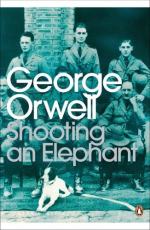|
This section contains 283 words (approx. 1 page at 400 words per page) |

|
Shooting an Elephant Summary & Study Guide Description
Shooting an Elephant Summary & Study Guide includes comprehensive information and analysis to help you understand the book. This study guide contains the following sections:
This detailed literature summary also contains Bibliography and a Free Quiz on Shooting an Elephant by George Orwell.
George Orwell's "Shooting an Elephant" first appeared in 1936. The British public already knew Orwell as the socially conscious author of Down and Out in London and Paris (1933), a nonfiction study of poverty, homelessness, unemployment, and subsistence living on poorly-paying menial jobs, and Burmese Days (1934), a novel of British colonialism. "Shooting an Elephant" functions as an addendum to Burmese Days. The story and novel share the same setting, and draw on Orwell's experience as a colonial official in India and Burma, two regions of the British Empire, in the middle of the century between the two world wars. The story (which some critics consider an essay) concerns a colonial officer's obligation to shoot a rogue elephant. The narrator does not want to shoot the elephant, but feels compelled to by a crowd of indigenous residents, before whom he does not wish to appear indecisive or cowardly. The situation and events that Orwell describes underscores the hostility between the administrators of the British Empire and their "native" subjects. Both sides feel hatred, distrust, and resentment. The situation is universally degrading. The shooting itself involves enormous pathos conveyed economically in a few words.
"Shooting an Elephant" is a central text in modern British literature and has generated perhaps more criticism than any other comparable short piece. In the politicized atmosphere of contemporary criticism, commentators are especially drawn into debate about whether Orwell apologizes for or condemns imperialism. Left-wing critics see insufficient condemnation; conservative critics point out that it is the narrator, an agent of empire, who explicitly denounces the British presence as pervasively corrupting to both sides. The story is one of the most widely anthologized and studied items of the modern English-language canon.
Read more from the Study Guide
|
This section contains 283 words (approx. 1 page at 400 words per page) |

|



